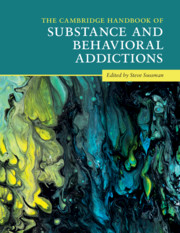Book contents
- The Cambridge Handbook of Substance and Behavioral Addictions
- The Cambridge Handbook of Substance and Behavioral Addictions
- Copyright page
- Contents
- Figures
- Tables
- Contributors
- Foreword
- Preface
- Acknowledgements
- Part I Concepts of Addiction
- Part II Clinical and Research Methods in the Addictions
- Part III Levels of Analysis and Etiology
- 10 Neurobiology of Substance Addictions
- 11 Neurobiological Foundations of Behavioral Addictions
- 12 Multiple Memory Systems, Addiction, and Health Habits: New Routes for Translational Science
- 13 The Role of Culture in Addiction
- 14 The Physical and Social Environments as Determinants of Health: Implications for Substance and Behavioral Addictions
- Part IV Prevention and Treatment
- Part V Ongoing and Future Research Directions
- Index
- References
10 - Neurobiology of Substance Addictions
from Part III - Levels of Analysis and Etiology
Published online by Cambridge University Press: 13 July 2020
- The Cambridge Handbook of Substance and Behavioral Addictions
- The Cambridge Handbook of Substance and Behavioral Addictions
- Copyright page
- Contents
- Figures
- Tables
- Contributors
- Foreword
- Preface
- Acknowledgements
- Part I Concepts of Addiction
- Part II Clinical and Research Methods in the Addictions
- Part III Levels of Analysis and Etiology
- 10 Neurobiology of Substance Addictions
- 11 Neurobiological Foundations of Behavioral Addictions
- 12 Multiple Memory Systems, Addiction, and Health Habits: New Routes for Translational Science
- 13 The Role of Culture in Addiction
- 14 The Physical and Social Environments as Determinants of Health: Implications for Substance and Behavioral Addictions
- Part IV Prevention and Treatment
- Part V Ongoing and Future Research Directions
- Index
- References
Summary
Earlier neurobiological models of substance addictions proposed that addiction is the product of an imbalance between two separate, but interacting, neural systems: (1) an impulsive and amygdala-striatum dependent system that promotes automatic and habitual behaviors, and (2) a “reflective” prefrontal cortex dependent system for decision-making, forecasting the future consequences of a behavior, and inhibitory control. These impulsive and reflective systems are analogous to Daniel Kahneman’s model of System I and System II thinking, or the Behavioral Activation System (BAS) and the Behavioral Inhibition System (BIS). Here, the reflective system controls the impulsive system through several distinct mechanisms that regulate impulses. However, this control is not absolute – hyperactivity within the impulsive system can override the reflective system. Most prior research has focused either on the impulsive system (especially the ventral striatum and its mesolimbic dopamine projections) as a mechanism promoting the motivation and drive to seek drugs, or on the reflective system (prefrontal cortex) as a mechanism for decision-making and impulse control. More recent evidence suggests that a largely overlooked structure, the insula, also plays a key role in maintaining addiction (craving). Hence, a triadic model of addiction incorporates these three systems that are associated with archetypal behaviors in addiction: craving, motivation to procure the drug, poor decision-making, lack of impulse control, and deficits in self-regulation.
- Type
- Chapter
- Information
- The Cambridge Handbook of Substance and Behavioral Addictions , pp. 121 - 135Publisher: Cambridge University PressPrint publication year: 2020
References
- 43
- Cited by



